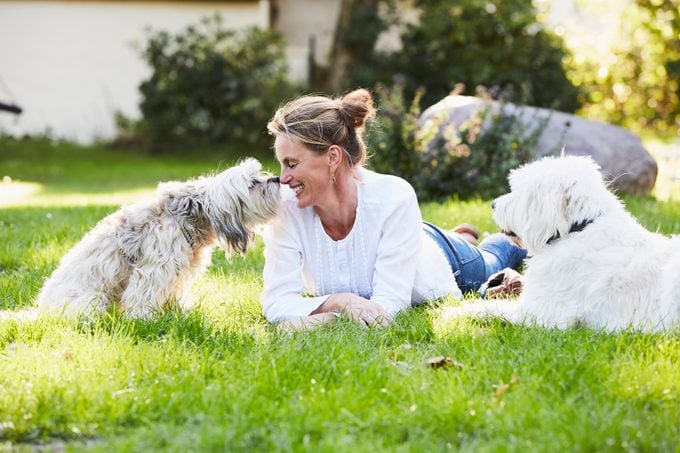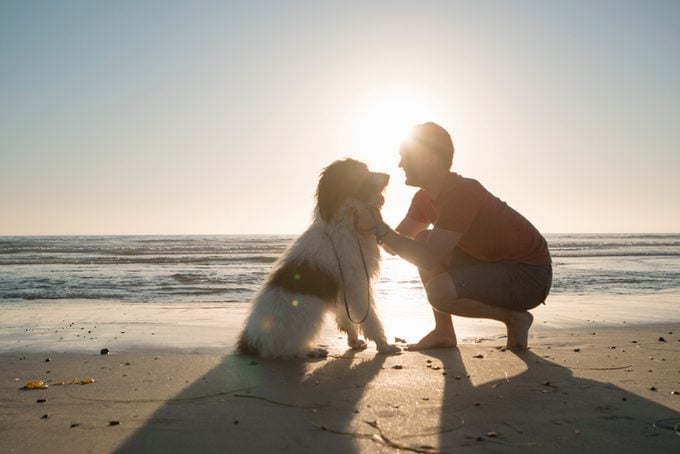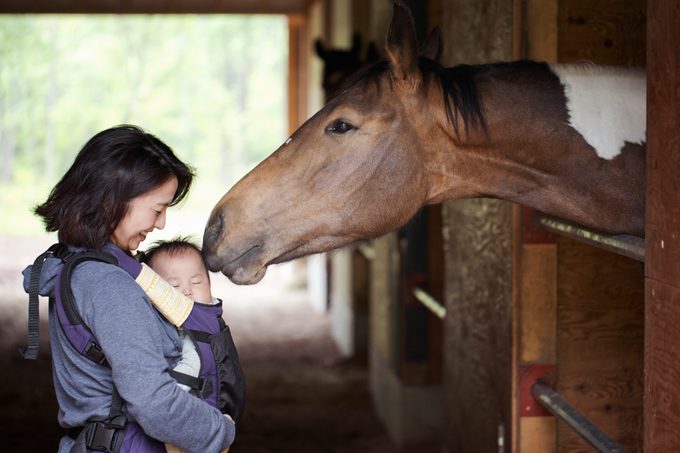Why It Feels So Good to Look in Your Dog’s Eyes
Updated: Mar. 16, 2022
When it comes to your dog, cat, or other pets, animal experts reveal how a mutual eye gaze enhances the human-animal bond and has positive effects on human health and wellbeing.
Raise your paw if you’re a sucker for puppy-dog eyes. Sure, dogs are cute—but did you know there’s a scientific reason why most people think so? Anecdotal evidence abounds, yet there’s an increasing amount of data-driven research on why people enjoy and benefit from gazing into a dog or other animal companion’s eyes. This special, two-way street of devotion is rooted in evolutionary, physiological, psychological, and social bonding between the species.
The American Veterinary Medical Association defines the human-animal bond as a “dynamic and mutual beneficial relationship between people and animals that is influenced by behaviors that are essential to the health and well-being of both.” A number of recent studies explore this bond in detail.

The human-animal bond
Katherine Compitus, licensed clinical social worker, animal behaviorist, and adjunct lecturer at Columbia University, New York University, and Fordham University is an expert in the field of human-animal bond (HAB). Compitus says the renowned physician and influential Enlightenment thinker John Locke wrote about the benefits of human-animal interactions in the 1600s, and the “father of psychoanalysis” Sigmund Freud was one of the first animal-assisted therapists. Freud would often incorporate his dog, Jofi, into sessions with patients in the 1930s.
“The field of HAB is just currently exploding because, historically, most of the evidence of the therapeutic benefit of HAB has been anecdotal,” says Compitus, who is chairman of Surrey Hills Sanctuary and author of the Zooeyia blog on PsychologyToday. “As more research is conducted into the therapeutic benefits of the human-animal bond, for humans and other species, we are seeing concrete quantitative and qualitative proof that HAB is a powerful treatment modality and that we really do benefit physiologically, psychologically and socially from our interactions with animals.”
It’s similar to the mother-child bond
According to Compitus, our human connection to dogs, cats, and other pets is similar to the bond between a mother and a child. This bond, in part, is formed through oxytocin, the hormone associated with love, attachment, and trust.
“Oxytocin is known as the love hormone since it becomes elevated in people when they fall in love or in mothers and their children when they interact,” says Compitus. “Studies show that oxytocin also becomes elevated in both humans and other animals when we interact.” And much like that human familial bond, oxytocin increases when people interact with their own pets versus other animals.
We also strengthen the bond by feeding and nurturing our pets; they are vulnerable and depend on us for nutritional needs and care.”The relationship between a human parent and child may be conditional and sometimes volatile, but a pet is a constant source of support and love,” says Compitus.
In addition, pets can provide opportunities to connect with other people, either in person or on social media, just as children do. “Aside from the physiological aspects, pets help us connect with others in our community … people meet their neighbors while walking the dog, or they create Instagram pages for their pets,” says Compitus.
Humans have a preference for “cute faces,” including animals
Another potential reason people benefit from looking in their dog’s or cat’s eyes is that our preference for cuteness in human babies and children extends to animal faces. A March 2016 article in Frontiers in Psychology builds on the hypothesis that infantile physical and behavioral features, or “baby schema,” attracts human attention to cats and dogs (and other animals), too.
The researchers say cats and dogs often play a central role in our lives, fulfilling attention and emotional intimacy needs much like human-human friendships. Their “cute faces” not only stimulate parent-like caretaking but are socially engaging as well, thus creating a mutually beneficial “feedback loop” that is positively associated with health and well-being.
Positive human-dog interactions decrease stress hormones
“Positive human-dog interactions have been observed to decrease cortisol levels and increase oxytocin levels not only in humans but also in dogs,” says Marta Borgi, co-author of the 2016 study in Frontiers in Psychology and research at the Center for Behavioral Sciences and Mental Health, Istituto Superiore di Sanità, Rome, Italy. “The next step would be to better explore which characteristics of the human-animal bond most impact on animal wellbeing, and the role of the oxytocin system and other physiological processes.”
“There is some evidence (a 2017 study in Frontiers in Psychology) that dogs excel in reading human social cues, including facial cues, that they discriminate between human facial regions and looked most to the eye region,” she says.
Compitus says interacting with animals has been shown to lower cortisol levels in humans, meaning “we feel less stressed when we pet an animal.”
There are a number of studies linking oxytocin and eye gaze (or eye tracking) behavior, but a June 2019 study published in the journal Proceedings of the National Academy of Sciences discovered that dogs have also evolved specific brow muscles that allow them to better communicate with humans.
This trait began to develop approximately 33,000 years ago, after dogs were domesticated from wolves. Dogs that were able to give this eyebrow cue were also more frequently adopted from shelters.

Dogs love human smiles
In the same way that many of us find a doggy grin adorable, another 2017 study published in Frontiers in Psychology found that dogs are similarly enamored by human smiles. The study describes how 43 dogs were shown images of smiling or angry human faces, and then the dogs were each tested twice.
The first time, they were under the influence of administered oxytocin, and the second time they weren’t given additional oxytocin. Next, the size of each dog’s pupils were measured with an eye-tracking device.
Emotional response and attentiveness are key factors that influence a dog’s gaze and regulate pupil size, so eye-tracking gives insight into the canine mind. (Previously, this method of tracking had only been used on humans and apes.)
While dogs tend to focus on threatening or dangerous social signals, the researchers found that oxytocin influenced the animals to ignore or override their survival instinct in favor of reacting to smiling human faces. Putting human happiness before their own safety may indicate just how loyal dogs really are to their people, possibly to a fault.
Pets ownership is on the rise
Over time, people have also become more enamored with the idea of keeping pets. Domestic animals are intertwined with our human lives, now more than ever.
Over the past four decades, the number of households with companion animals has increased quite a bit. According to a 2019-2020 survey by the American Pet Products Association (APPA), 67% of U.S. households include a pet (an increase from 56% of homes in 1988); that’s 84.9 million homes shared with dogs (63.4 million), cats (42.7 million), freshwater fish (11.5 million), saltwater fish (1.6 million), reptiles (4.5 million), birds (5.7 million), small animals (5.4 million) and horses (1.6 million).
The APPA predicts that in 2020, people will spend an estimated $99 billion on their pets. Additionally, the APPA reports that millennials (35% of U.S. pet owners) became the primary pet-owning demographic in 2016.
(These are the best air purifiers for pets to help control dander.)
More pets are being fostered and adopted during coronavirus
Considering the number of pets fostered and adopted during the pandemic thus far, there’s no signs of companion animal ownership decreasing any time soon.
“During the pandemic, many people are stuck at home, but with a pet, they at least have another being to hold, nurture, and love,” says Compitus. “Pet guardianship gives people something to do, and also provides humorous moments that can help alleviate anxiety about the state of the world.”
Compitus notes that social isolation is a major challenge in the human social work field, as it is often a symptom of depression (and social isolation can lead to depression). “Pets alleviate social isolation because they are another living being to talk to, to care for, feed, take on walks, etc., and who we perceive loves us unconditionally and without judgment,” she says.
Relationships with animals can be similar to human-human relations
Borgi, who has done in-depth research on human-animal relationships agrees that pets can also help reduce feelings of social isolation in humans.
“Relationships with animals have similar characteristics of human-human relations—emotional intimacy, companionship, trust, loyalty, commitment, affection, acceptance, sympathy, concern for the other’s welfare, as well as time spent together and maintenance of the pair bond after long separations,” says Borgi.
“Many owners live closely with their pets, sharing with them their domestic space and financial resources, view them as psychological-kin and equal members of the family … the time we invest in meaningful human-human relationships serves important biological functions: the quality and quantity [of] social interactions influence our immune functioning, how quickly we recover after an illness and, ultimately, how long we live.”
Borgi says our human social environment is one of the most important risk and/or protective factors related to mortality, exceeding other major risk factors, including obesity and physical inactivity.

Dogs may add ‘dog years’ to your life
Pascal Janne, researcher at Université Catholique de Louvain, Yvoir, Belgium and co-author of a 2020 study in French journal Annales Médico-Psychologiques, says that “horses, cats, and fur-bearing animals are likely to produce additional immune benefits” and general health and wellbeing in people.
Plus, some people decide that having an animal who depends on them “is a very good reason to quit smoking, to stay healthy … see a doctor or take medicine,” notes Compitus. Researchers have found that people with pets may be less likely to take their own lives “because they worry about what will happen to their pet when they are gone,” she says.
A 2019 study, published in the journal Circulation: Cardiovascular Quality and Outcomes, found a connection between pet ownership, particularly dogs, and survival after a major cardiovascular event such as a heart attack and stroke.
The researchers found pet owners had higher levels of physical activity and social support than non-pet owners, which could improve health outcomes after a cardiovascular event. While previous studies suggest that companion dogs improve human physical activity, help lower blood pressure, and increase social interactions with other people (and animals), this study focused specifically on heart health.
“We have found that dog owners fare better after a myocardial infarction (heart attack) or stroke, and the differences were largest in the single household group,” says Tove Fall, author of the study and a professor in molecular epidemiology at Uppsala University in Uppsala, Sweden. “We hypothesize that this could be due to effects of regular physical activity or related to psychosocial factors.”
Fall and her colleagues found that in comparison to non-dog owners, people who lived alone had a 33% lower risk of death after hospitalization for a heart attack. Along those same lines, dog owners who lived with a partner or child, had a 15% lower risk of a heart attack after a previous hospitalization. (Stroke survivors with dogs were also shown to have less risk.)
“We know that loneliness is a strong risk factor for premature death, and maybe a pet can relieve social isolation,” Fall says. “Pets are great company and add meaningfulness … especially for people that live alone, a pet can be great company during lockdown. Also in some countries, you could only take walks if you had a dog.”
That said, as a researcher, Fall feels the association between the human-animal bond and human health is hard to study.
“We do not know if and how personalities and other characteristics that can affect health differ between pet owners and non-pet owners,” explains Fall. “It is hard to separate health effects from the pet from differences in owner characteristics (some people who like physical activity might me more prone to get a dog that they will take out for long walks). It is hard to know if their dog made them exercise or vice versa.”
Other animals can form a special pattern of attachment
While dogs are the most studied pets, other animals―such as cats and horses―have also evolved alongside humans, and are also capable of forming a special pattern of attachment to people.
“They adapt specifically to their new and unique habitat, namely, human societies,” says Borgi. “In the case of dogs, the most ancient domestic species, the domestication process has influenced dog behavior, making these animals skillful in following human communication, unique and specialized in reading human communicative cues, and [able] to use the communicative gestures of humans (such as pointing). Not even our closest living relatives, chimpanzees, can do this as efficiently as dogs.”
Although many millions of birds, reptiles, small mammals and fish are also kept as pets, Borgi says “these animals did not undergo an evolutionary process (such as domestication) that could have made them adapt to the cohabitation and relationship with humans.”
She cautions that this means that humans are not automatically able to meet the needs of many other types of animal, such as those that aren’t domesticated. “A wild animal’s needs and natural behaviors cannot be easily met in our home,” says Borgi.

Keep in mind, too, that not all domestic animals live inside the home. Horses may not be typical house pets, but that doesn’t mean they can’t effectively relate to humans and us them.
A 2019 study in the journal Animals researched both dog-human and horse-human interactions with children. The authors say that, like dogs, horses are often tuned-in to emotional and physical cues of humans, including our voices, expression, posture, and more.
In the field of equine therapy, in particular, working with and riding horses can help children (and adults) with relationship-building skills, such as “trust, communication, confidence, [and] problem-solving skills.”
According to the authors, “the sheer presence of a horse demands respect, and the emotional and cognitive state of the individual responds by attempting to gain their trust and respect … connections with horses may … encourage the growth of self-esteem … once a relationship between a horse and a human is established, rapport begins to grow … this in turn gives a feeling of inner pride, empowerment, and accomplishment.”
Compitus agrees. She says that although dogs have a “uniquely symbiotic relationship with people,” the next closest animal is probably the horse.
While they’ve been domesticated for only about 5,000 years (for dogs, it’s hypothesized to be around 33,000 years), horses “can be very in tune to human feelings.” It may seem surprising at first, but miniature horses are the only species, aside from dogs, that are accepted by the ADA (Americans with Disabilities Act) as working service animals.
Along with dogs, the authors of the Animals study believe that horses make ideal therapy and companion animals because of their “natural ability to attune to others, to observe, evaluate and respond authentically and immediately to non-verbal attitudes and behaviors.”
In fact, they compare dressage (a skilled art form of riding performed in exhibition and competition) to dog walking in terms of harmony, synchronicity, and rhythm. They conclude by wondering if “when we touch a dog or a horse (or any other species for that matter), we touch our own ‘animality’ in entangled empathy with them.”
Along those same lines, perhaps when we look into the eyes of a beloved dog, we are each seeing―and experiencing―thousands of years of co-adaptive behavior, emotions, and friendship. All that and they’re soft and cuddly, too.
